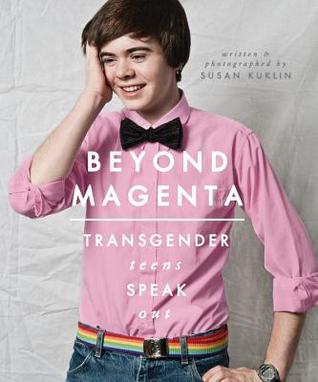
I read Beyond Magenta: Transgender Teens Speak Out, by Susan Kuklin, for this year’s Banned Books Week, since it has popped up in the American Library Association’s Top 10 Challenged Books list several times since it was published in 2014.
The book is fairly short, only 182 pages in hardcover. Six teens talk about their gender identities and journeys towards transitioning. Two of them (Jessy and Luke) transition from male to female, two from female to male (Christina and Mariah), and two (Cameron and Nat) are non-binary, using they/them pronouns and not identifying as either male or female. Of those two, Cameron—the teen pictured on the cover—presents as more feminine or more masculine depending on their mood, while Nat is intersex and apparently asexual, preferring to present as neutral/ambiguous.
The reasons given for the book being challenged include its LGBTQIA+ content and because it is considered to be sexually explicit. There are some passages that mention sex and anatomy, but that’s hardly surprising, given the subject matter, and they don’t seem unreasonable given the context. Besides, the odds are good that any teen with access to the internet or who has ever been in a high school gym locker room has been exposed to a lot worse. The adults who worry that books like this will “give kids ideas” really need to get a grip. It seems unlikely to me that most teens would be interested in reading this book unless they were already experiencing gender dysphoria, and if they are, withholding information about similar people’s experiences—including the impacts on their physical bodies—is simply cruel.
That said, this didn’t strike me as a particularly good book. For one thing, it isn’t really clear who the expected audience is; it feels as if it is targeted more towards cisgender adults trying to understand transgender teens rather than the teens themselves. For another, the organisation is less than ideal; the most interesting chapters (at least, to me) are all in the second half of the book, and some readers will bail before they get that far.
And then there are the narratives: they are in the teens’ own words, but are drawn from interviews by the cisgender author, so there was non-trivial editing involved on her part. Since she doesn’t give us the questions she asked, it’s hard to tell how much she drove the direction the interview took, or where the subject was more or less forthcoming. In addition, in the first chapter, Jessy and his girlfriend talk about their relationship. He claims he’s happy, but his girlfriend refuses to refer to him by his chosen pronouns (he/him). That makes me wonder if his claims that his family and friends are supportive are overstated in an attempt to convince the author—or perhaps even himself—and left me with persistent doubts about the emotional honesty throughout the book.
There were also some really unfortunate gender stereotypes expressed. I suppose it isn’t fair to expect a high degree of self knowledge and articulation from a group of otherwise rather ordinary teens who are still struggling to come to terms with their own identities, but I have little patience for the idea that loving to shop for pretty clothes equates with being a girl. (I never have enjoyed shopping for clothes. I hardly ever wear a dress. I despise pantyhose and heels. I’m not trans.)
Before reading this book, I had hoped it would illuminate a gender dysphoria strong enough to drive someone to transition. Unfortunately, it didn’t give me any new insights into what makes someone do something so life-altering.
But just because this book doesn’t speak to me, doesn’t mean it wouldn’t be useful to someone else.
A few notes on the chapters I found most interesting:
- They include the ones about the non-binary teens, Cameron and Nat, possibly because they were less invested than the others in gender stereotypes.
- Nat’s story was the one that resonated the most with me, although as much for their efforts to be taken seriously as a musician as for their story about gender identity.
- Similarly, Luke’s involvement in theatre gave an extra dimension to his story.
